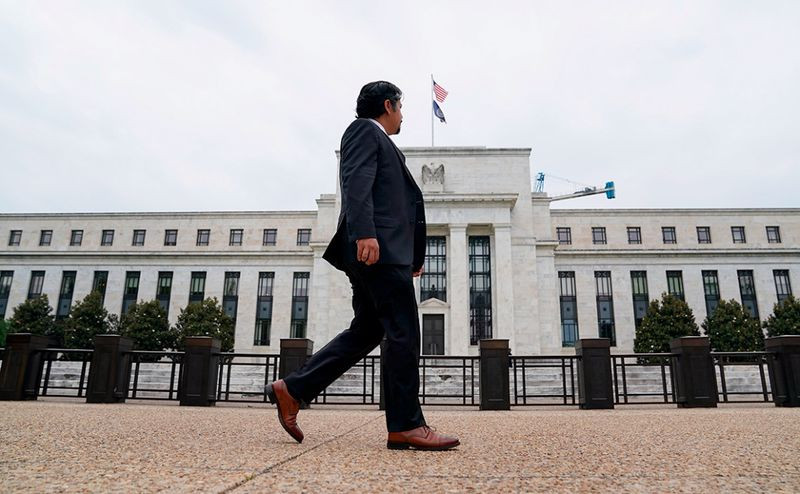
The greenback remained stable, despite the fact that data published at the end of last week showed that the US economy in September created the smallest number of jobs in nine months.
At the same time, the EUR/USD pair, having demonstrated a modest rebound, suffered losses for the fifth consecutive week, falling by almost 0.2% following the results of the last five days.
The USD index sank to local lows around 94.00 points after the US Department of Labor reported on Friday that the number of jobs in the country increased by 194,000 in September, which turned out to be significantly lower than the projected growth of 500,000.
However, then the US currency was able to reduce losses due to the fact that after the initial negative reaction to the headline, investors paid attention to the details.
Thus, the number of people employed in the non-agricultural sector of the United States in August was revised upward – from 235 to 366,000. The average hourly wage in the country rose by 0.6% on a monthly basis and by 4.6% on an annual basis, and unemployment fell to 4.8%, reaching the lowest level since March 2020.
The dollar was also supported by an increase in the yield of 10-year treasuries to the highest level since the beginning of June (1.617%) on Friday, which showed that even a miss in US employment in September would not shift the Federal Reserve's trajectory by a single millimeter.

"The dynamics of USD suggests that market participants see positive sides, while maintaining expectations regarding the Fed's decision to reduce QE around November or December, with the first increase in interest rates in the fall of 2022," Cambridge Global Payments analysts noted.
"The main details of the September report on the US labor market and the revised values are not as discouraging as one might initially assume, and, ultimately, the latest value on American employment still maintains the Fed's commitment to reducing QE next month," TD Securities analysts said.
"Given the way the dollar has been trading recently and its close correlation with the relative momentum of data surprise, weakness was not ruled out. But we do not think that the last figure is convincing enough to cause a serious reversal for the USD. At the same time, the 1.1600 level will be key for the EUR/USD pair, but we expect it to be a strong resistance," they added.
The main currency pair is still having difficulty attracting bulls, as investors are of the opinion that the US central bank will begin to curtail monetary incentives earlier than its European counterpart.
European Central Bank President Christine Lagarde believes that the central bank should not rush to tighten monetary policy, as this could jeopardize the recovery of the eurozone economy and lead to job losses.
"Premature tightening of monetary policy at the current stage could jeopardize the economic recovery of the eurozone and lead to job losses," she said on Friday.
Lagarde also reiterated that one should not overreact to the current surge in inflation in the eurozone, since the price increase is largely a temporary phenomenon.

Meanwhile, on the other side of the Atlantic, concerns are growing about the unwinding of the wage-price spiral.
Although Fed Chairman Jerome Powell remains calm and does not get tired of talking about the transient nature of inflation, the FOMC seems to be growing alarmed that the pace of job creation in the US is slowing sharply with the continuing high level of consumer prices, as well as wage growth, which looks solid and shows signs of acceleration.
The recent increase in the yield of 10-year treasuries to four-month highs hints that the US central bank may have to slow down the growth of price pressure in the country, sooner rather than later. If the Fed continues to sit idly by, then inflation, like a dog, will no longer just bark, but will start biting quite hard in the coming months.
Thus, the specter of a labor shortage still remains in place, supporting concerns about inflation and giving the Fed grounds to reduce stimulus measures. This in turn pushes US bond yields up, increasing the appeal of the dollar in the eyes of investors.
"The Fed's ongoing hawkish policy shift, coupled with more persistent risks of higher inflation, continues to put upward pressure on US yields and the dollar. Even after the recent hawkish revaluation, the futures market still does not expect the federal funds rate to exceed 1.00% by the end of 2023," MUFG Bank strategists said.
"Our yield-based pricing model indicates that the current fair value for the EUR/USD pair is approximately in the middle of the 1.1000-1.1500 range. This means that the pair is currently trading about 2.5-3.0% above fair value," they added.
The factors that have supported the greenback in recent months remain in force, and there is reason to believe that the US currency will remain at the forefront during the winter in the Northern Hemisphere, Rabobank notes.
"The decline in the US unemployment rate in September, along with the upward revision of wage gains over the previous two months, apparently reinforced the view that the accumulated progress is sufficient for the Fed to move forward in its plans to reduce the bond purchase program in the coming months. Therefore, we believe that the factors that led to the recent growth of the USD, in fact, remain in place," the bank's analysts said.
They tend to view attempts to raise the main currency pair as an opportunity to expand long positions in dollars and have moved their 12-month EUR/USD target of 1.1500 to a three-month perspective.
On Monday, the USD index was trading with an increase of more than 0.2%, around 94.30 points, keeping close to the annual highs reached earlier this month.

The US currency may strengthen even more if data on consumer prices in the US, due to be published on Wednesday, reflect an increase in inflation and raise expectations of an earlier rate hike next year, CBA analysts say.
"The US dollar may maintain significant growth this week, as attention will be drawn to expectations of a Fed rate hike next year," they said.
According to forecasts, annual inflation in the United States by the end of September remained at an elevated level of 5.3%.
In addition, the minutes from the Fed's September meeting will be made public, which may give market participants hints about the central bank's future plans regarding its policy.
In case of strengthening the bullish momentum, the USD index may retest the highs of 2021 near 94.50. Further, the resistance is in the area of 94.75, supported by the 200-week moving average, the breakthrough of which will open the way to the round level of 95.00.
It is assumed that the index will remain positive while it is trading above the 200-day moving average, which is now at 91.70.
As for the EUR/USD pair, at the beginning of the new week it is consolidating under the 1.1600 mark.
The initial resistance is located near 1.1585. The next barrier appears at 1.1620 (the Fibonacci retracement level is 23.6% relative to the downward trend originating in September). The pair may target 1.1650 and 1.1680 above this barrier.
On the other hand, the nearest support is at 1.1560 before 1.1530 (the 15-month low recorded on October 6) on the way to the psychologically important level of 1.1500.
 English
English 
 Русский
Русский Bahasa Indonesia
Bahasa Indonesia Bahasa Malay
Bahasa Malay ไทย
ไทย Español
Español Deutsch
Deutsch Български
Български Français
Français Tiếng Việt
Tiếng Việt 中文
中文 বাংলা
বাংলা हिन्दी
हिन्दी Čeština
Čeština Українська
Українська Română
Română

